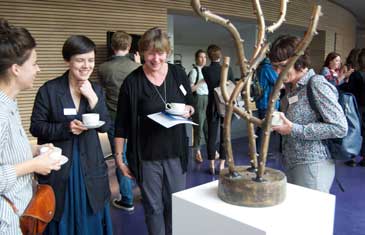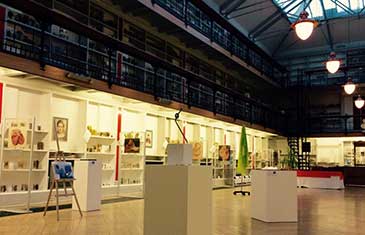The Matter of Objects: Putting on an Interdisciplinary Exhibition

Written by Ella Kilgallon and Hannah Lee, PhD Students at the School of History
The Matter of Objects was a pop-up exhibition and discussion event that took place in May 2016, bringing together artists and humanities scholars in a collaborative discussion about the role that objects play in our understanding of history. In our last blog post we covered how we created the collaborations and promoted the exhibition, now we get onto the practice.
Two days prior to the public exhibition we brought all of our collaborators together for a workshop to reflect on their experience, discuss the process, and share with each other their pieces and projects. From these conversations the value of collaboration was immediately obvious.
The artists resoundingly agreed that collaborating with someone in a different field who was specialised in a subject unknown to them allowed their art to take on a different angle. The opportunity to speak about their art to a captive audience was also refreshing as many commented that such open and extended conversation was rarely a part of the process. The researchers were also in agreement that the collaboration had given them a new insight into their work as the artists were able to draw connections and express ideas that they themselves had sometimes struggled to articulate.
Following the workshop and a private view of the collection, the eight objects were displayed in a one-day pop-up event at the Barts Pathology Museum that welcomed the public to respond to the collaborations.

A relic to Victorian collecting Barts offered a unique space to view the pieces and listen to the introductions and discussion around each piece. Keen to share the conversations and connections drawn from the day prior we offered tours around the exhibit providing an overview of the original project, the artists’ rationale in creating their piece, and the researchers’ response.
Unexpectedly two pieces worked particularly well in this setting. Annie Thwaite’s research on the material culture of healing and Timothy Gasbarro’s response Feitiço spoke to the Pathology Museum’s collection and the history of medicine. While Natalie Lawrence and Dominique Russell’s collaboration that resulted in BOP Untitled emphasised the disjointed body of the exotic bird in a way akin to the specimens displayed permanently at the museum.
It was fascinating to see artworks surrounded by pathology specimens, tied in really well!
Anonymous visitor feedback
Alongside the exhibition there was an opportunity to participate in a printmaking workshop run by one of the artists, Sarah Jarman. Sarah gave people the chance to try mono printing while talking about the different types of print and their uses. Having an informal space for visitors to be creative encouraged further conversation about the pieces and the project as a whole. During the exhibition day we received around 60 visitors ranging in age and profession. Students of the humanities, museum professionals, artists, those generally interested in history, and Barts staff were all welcomed to the exhibition. Visitors were encouraged to join the conversation and ask questions about any aspect of the project, as well as writing anonymous feedback.
It is interesting to see how each object, its history and material substance inform and inspire each artist in different ways. The interpretation of ancient objects using contemporary media highlights the tensions and similarities between materials well and this is great to see.
Anonymous visitor feedback
The Impact
Before starting this project as co-curators we questioned the real impact of collaboration between art practitioners and historical researchers. What could these two groups actually learn from one another? Would such collaboration bring fresh perspectives to both fields of enquiry? How could collaboration succeed in making historical research more accessible to wider audiences?
From conversations between artists and researchers and between participants and the public it quickly became apparent that collaboration of this kind could be both beneficial and energising. The conversations between artists and researchers revealed that each gave to the other a new angle on their existing work as well as a diverse forum within which to discuss their thoughts and processes. Ideas took a more physical form in the hands of the artists enabling the researchers to gain an alternative perspective on their projects.
Conversations with members of the public showed that even very niche topics of historical enquiry were engaging when explored through objects and artist interpretation. These different layers of interpretation enabled more space for questioning, comment and intrigue.
A really fantastic way of getting researchers and artists to think more broadly about their work, and different ways of approaching it. It’s certainly helped me think about my own research in new and exciting ways. Having the exhibition in two quite different spaces is highly innovative and make the whole event a unique and inspiring collaboration.
Anonymous visitor feedback
Poignant dialogue between the art objects and the museum artefacts. Adds another narrative layer to the collaboration.
Anonymous visitor feedback
Written by Ella Kilgallon and Hannah Lee
PhD students
School of History
Queen Mary University of London
https://matterofobjects.wordpress.com/
@MatterObjects
@EllaKilgallon